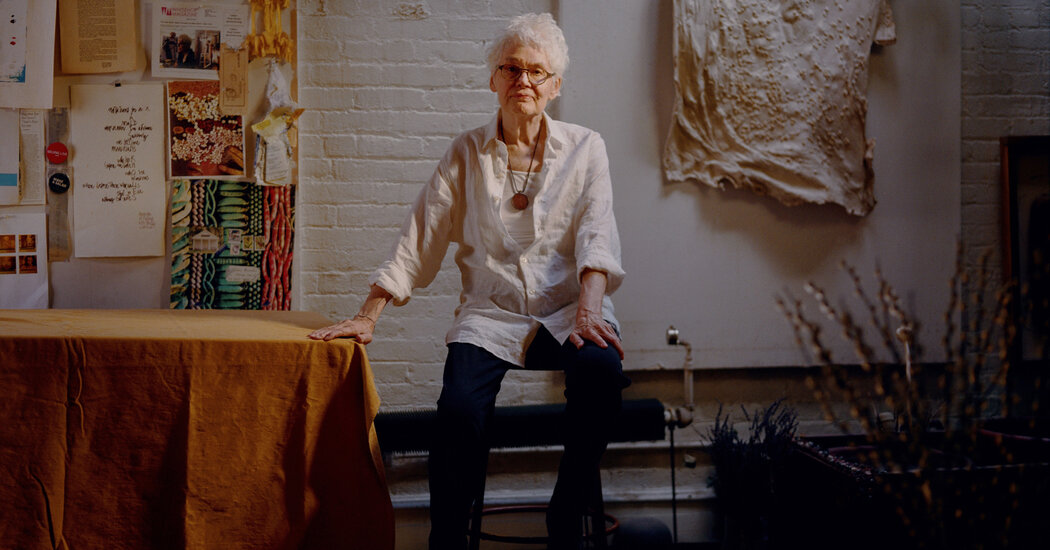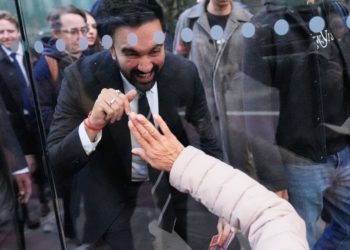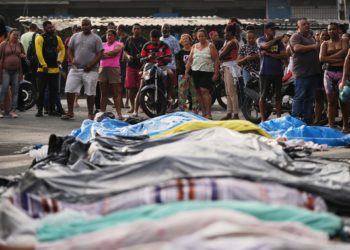Alison Knowles, the New York artist known for making accessible and participatory artworks out of such everyday things as the tuna sandwich on wheat toast, which she ate routinely for lunch, or a simple salad prepared with iceberg lettuce, died on Wednesday at her longtime home in Manhattan. She was 92.
Her death was confirmed by her daughter Hannah B Higgins.
Ms. Knowles began her tuna sandwich piece, called “The Identical Lunch,” in 1967, after a friend noticed that she placed the same order every day at a diner in the Chelsea section of Manhattan. She turned it into a highly digestible private-public performance by writing out and following a simple sort of recipe:
“A tuna fish sandwich on wheat toast with lettuce and butter, no mayo, and a large glass of buttermilk or a cup of soup was and is eaten many days of each week at the same place and at about the same time.”
She invited friends — and later hungry museumgoers — to join her for the ordinary-seeming meal, and she documented some of the feasts in journals and Polaroids.
Her first major food performance, “Make a Salad,” which involved preparing and serving a salad of iceberg lettuce for visitors, was staged at the Institute of Contemporary Arts in London in 1962. The work was reprised in recent years at various venues, from the Tate museum in London to the High Line in New York, featuring ever larger salads as her audience grew — so large that sanitized rakes were used to toss the salad and shovels to serve it.
Ms. Knowles’s style of interactive and often personable art, which by design is challenging to display and preserve in a museum, now goes by the heady name relational aesthetics. But the key concept was originally known as an “event score,” a term, coined by the artist George Brecht, that nodded to the idea of artist as composer and the performance as something that could be endlessly reinterpreted.
Ms. Knowles created many of these handwritten or typed event scores in the 1960s as an early participant in Fluxus, a chance-loving, performance-oriented, eccentric collection of artists led by the charismatic Lithuanian immigrant George Maciunas. (He later made his own version of Ms. Knowles’s tuna sandwich work by proposing that the meal be put in a blender and served as a drink.)
Ms. Knowles was one of the few women involved in Fluxus, a fact that inflected her work, said Karen Moss, a curator who organized a traveling Knowles retrospective for the Berkeley Art Museum in 2022. (It will reach the Grey Art Museum in New York in October 2026.)
“Some Fluxus works were very curt, short actions like Nam June Paik’s smashing of a violin,” Ms. Moss said in an interview. “Alison’s were often more durational, with ‘Make a Salad’ involving everything from shopping for ingredients and chopping the lettuce, with contact mics capturing the sound of food prep, to serving and eating the food.
“Her works are multisensory experiences,” she said, adding that they tended to be highly collaborative. “I would call them convivial and communal.”
This all made her art challenging to sell, the New York gallerist James Fuentes said. “I believe her most potent works were her most ephemeral works,” he said. “It’s hard to put your arms around it, inventory it or sell it.”
Continuing with her own blend of sensory, participatory work well beyond the heyday of Fluxus in the 1960s, Ms. Knowles became known for a couple of signature elements. One was beans, which she praised as “affordable and available.” She cooked with them regularly and made art with them frequently, embedding them in handmade paper or placing them loose in paper pouches to turn them into sound makers.
Another touchstone was books. Over the years, Ms. Knowles created numerous artists’ books, sheets of handmade paper and booklike sculptures. She also made walk-in installations inspired by the form of books, with eight-foot-tall walls that resembled pages.
Her most famous installation was “The House of Dust,” a fiberglass structure that originated with a poem she helped write in 1967. Her co-author on the poem was a Fortran computer program designed by James Tenney, an experimental composer, to produce different quatrains from set phrases that she had supplied.
Celebrated as one of the first computational poems, the work included stanzas like “a house of dust / on open ground / lit by natural light / inhabited by friends and enemies” and “a house of plastic / in a metropolis / using natural light / inhabited by people from all walks of life.”
Taking inspiration from that last image, Ms. Knowles built an actual fiberglass structure for small gatherings. The first iteration of the building, a pair of bulbous forms installed outside a housing development in Chelsea, functioned mainly as a play structure. But the residents were not involved in the process of selecting the artwork and petitioned to have it removed. (It was the victim of arson before that happened.)
In 1970, invited by the Happenings guru Allan Kaprow to teach at the California Institute of the Arts, Ms. Knowles stipulated in her contract that the newly restored five-ton “house” be moved there, where it was much more well received. It ended up being used for classes, film screenings, picnics, gift exchanges and more, culminating with a helicopter dropping printouts of the “House of Dust” poem on the site — an action that combined literature, performance and a sprinkling of mayhem.
Alison Knowles was born in Manhattan on April 29, 1933, to Edwin and Lois (Beckwith) Knowles. Her father was a professor of English literature at Pratt Institute in Brooklyn; her mother worked mainly in nursing.
As a teenager, Alison made small books for her father, “which were basically Walt Disney figures with maybe a different story for Bambi or Dumbo, because I could draw the figures,” she told an interviewer for the Smithsonian Archives of American Art in 2010. She started her studies at Middlebury College in Vermont as a French major but transferred to Pratt and completed a Bachelor of Fine Arts degree there in 1956.
Ms. Knowles made and exhibited abstract paintings in the 1950s. An early settler of SoHo, she lived in a loft on Canal Street and Broadway with her first husband, James Ericson. That marriage was brief, and in 1960 she married the writer Dick Higgins, who became her partner for years in the avant-garde art circles of the day.
Ms. Knowles credited Mr. Higgins with inspiring her to return to her literary roots. He also introduced her to the composer John Cage, who became a close friend and collaborator. She didn’t take Cage’s famous composition class at the New School, she told the artist Aviva Rahmani in a 1991 interview, “but the mechanisms and structure discussed in that class helped me escape the ravening jaws of Abstract Expressionism.”
She began to write books and poems herself. “It wasn’t that I had left painting, but I definitely was doing other things,” she said in the Smithsonian interview. “Words like ‘intermedia’ were coming into the culture. I used to do a whole evening of sound, and I’d call it ‘sound and poetry’ or ‘sound poetry,’ in nearby galleries, which would consist in putting some of my bean collections into sonic paper bases and shaking them.”
In 1964, Mr. Higgins started Something Else Press to publish experimental books. He originally wanted to name his company Shirt Sleeves Press, but when he ran this idea past Ms. Knowles, she thought it weak. “You should call it something else,” she said. He took her cue and did.
That same year, the couple had twin daughters, Jessica and Hannah. The couple divorced in 1971 but remarried in 1984; Mr. Higgins died in 1998. Hannah Higgins, a scholar of avant-garde art who teaches at the University of Illinois Chicago, described her parents’ relationship in a catalog essay as “deep and rich and unconventional.”
“He was gay,” she wrote of her father. “His partners were also part of the family. We called them uncles and brothers.”
In addition to her daughter Hannah, Ms. Knowles is survived by another daughter, Jessica A Higgins, an artist, and three granddaughters.
Ms. Knowles engaged in extensive collaborations with friends like Mr. Cage, who created books and performances with her; they also went mushroom hunting together. “I cannot think of a single close friend with whom Alison has not, at a fundamental level, collaborated,” Hannah Higgins wrote.
In this way, art for Ms. Knowles became a way of inviting people, and happenstance, into her space.
“Performance art now allows for so much human activity that was never available when I started out on a concert stage,” she said in 2022. “The concept of performance now includes food, children, the weather, you name it, everything — I like that.”
The post Alison Knowles, Artist Who Took Lunch to New Levels, Dies at 92 appeared first on New York Times.




